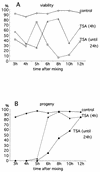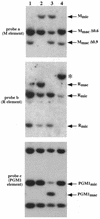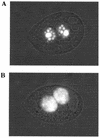Role of histone deacetylation in developmentally programmed DNA rearrangements in Tetrahymena thermophila
- PMID: 12455963
- PMCID: PMC118033
- DOI: 10.1128/EC.1.2.293-303.2002
Role of histone deacetylation in developmentally programmed DNA rearrangements in Tetrahymena thermophila
Abstract
In Tetrahymena, as in other ciliates, development of the somatic macronucleus during conjugation involves extensive and reproducible rearrangements of the germ line genome, including chromosome fragmentation and excision of internal eliminated sequences (IESs). The molecular mechanisms controlling these events are poorly understood. To investigate the role that histone acetylation may play in the regulation of these processes, we treated Tetrahymena cells during conjugation with the histone deacetylase inhibitor trichostatin A (TSA). We show that TSA treatment induces developmental arrests in the early stages of conjugation but does not significantly affect the progression of conjugation once the mitotic divisions of the zygotic nucleus have occurred. Progeny produced from TSA-treated cells were examined for effects on IES excision and chromosome breakage. We found that TSA treatment caused partial inhibition of excision of five out of the six IESs analyzed but did not affect chromosome breakage at four different sites. TSA treatment greatly delayed in some cells and inhibited in most the excision events in the developing macronucleus. It also led to loss of the specialized subnuclear localization of the chromodomain protein Pdd1p that is normally associated with DNA elimination. We propose a model in which underacetylated nucleosomes mark germ line-limited sequences for excision.
Figures








Similar articles
-
A novel chromodomain protein, pdd3p, associates with internal eliminated sequences during macronuclear development in Tetrahymena thermophila.Mol Cell Biol. 2000 Jun;20(11):4128-34. doi: 10.1128/MCB.20.11.4128-4134.2000. Mol Cell Biol. 2000. PMID: 10805754 Free PMC article.
-
An essential role for the DNA breakage-repair protein Ku80 in programmed DNA rearrangements in Tetrahymena thermophila.Mol Biol Cell. 2012 Jun;23(11):2213-25. doi: 10.1091/mbc.E11-11-0952. Epub 2012 Apr 18. Mol Biol Cell. 2012. PMID: 22513090 Free PMC article.
-
Lia1p, a novel protein required during nuclear differentiation for genome-wide DNA rearrangements in Tetrahymena thermophila.Eukaryot Cell. 2007 Aug;6(8):1320-9. doi: 10.1128/EC.00157-07. Epub 2007 Jun 22. Eukaryot Cell. 2007. PMID: 17586719 Free PMC article.
-
Dynamic nuclear reorganization during genome remodeling of Tetrahymena.Biochim Biophys Acta. 2008 Nov;1783(11):2130-6. doi: 10.1016/j.bbamcr.2008.07.012. Epub 2008 Jul 28. Biochim Biophys Acta. 2008. PMID: 18706458 Free PMC article. Review.
-
Small RNAs in genome rearrangement in Tetrahymena.Curr Opin Genet Dev. 2004 Apr;14(2):181-7. doi: 10.1016/j.gde.2004.01.004. Curr Opin Genet Dev. 2004. PMID: 15196465 Review.
Cited by
-
SUMOylation is developmentally regulated and required for cell pairing during conjugation in Tetrahymena thermophila.Eukaryot Cell. 2015 Feb;14(2):170-81. doi: 10.1128/EC.00252-14. Epub 2014 Dec 19. Eukaryot Cell. 2015. PMID: 25527524 Free PMC article.
-
snRNA and heterochromatin formation are involved in DNA excision during macronuclear development in stichotrichous ciliates.Eukaryot Cell. 2005 Nov;4(11):1934-41. doi: 10.1128/EC.4.11.1934-1941.2005. Eukaryot Cell. 2005. PMID: 16278460 Free PMC article.
-
Sirtuin-mediated nuclear differentiation and programmed degradation in Tetrahymena.BMC Cell Biol. 2011 Sep 21;12:40. doi: 10.1186/1471-2121-12-40. BMC Cell Biol. 2011. PMID: 21933443 Free PMC article.
-
Study of an RNA helicase implicates small RNA-noncoding RNA interactions in programmed DNA elimination in Tetrahymena.Genes Dev. 2008 Aug 15;22(16):2228-41. doi: 10.1101/gad.481908. Genes Dev. 2008. PMID: 18708581 Free PMC article.
-
Programmed DNA Elimination in Vertebrates.Annu Rev Anim Biosci. 2021 Feb 16;9:173-201. doi: 10.1146/annurev-animal-061220-023220. Epub 2020 Sep 28. Annu Rev Anim Biosci. 2021. PMID: 32986476 Free PMC article. Review.
References
-
- Almouzni, G., S. Khochbin, S. Dimitrov, and A. P. Wolffe. 1994. Histone acetylation influences both gene expression and development of Xenopus laevis. Dev. Biol. 165:654-669. - PubMed
-
- Asai, D. J., and J. D. Forney. 2000. Tetrahymena thermophila, vol. 62. Academic Press, San Diego, Calif.
Publication types
MeSH terms
Substances
Grants and funding
LinkOut - more resources
Full Text Sources
Research Materials

